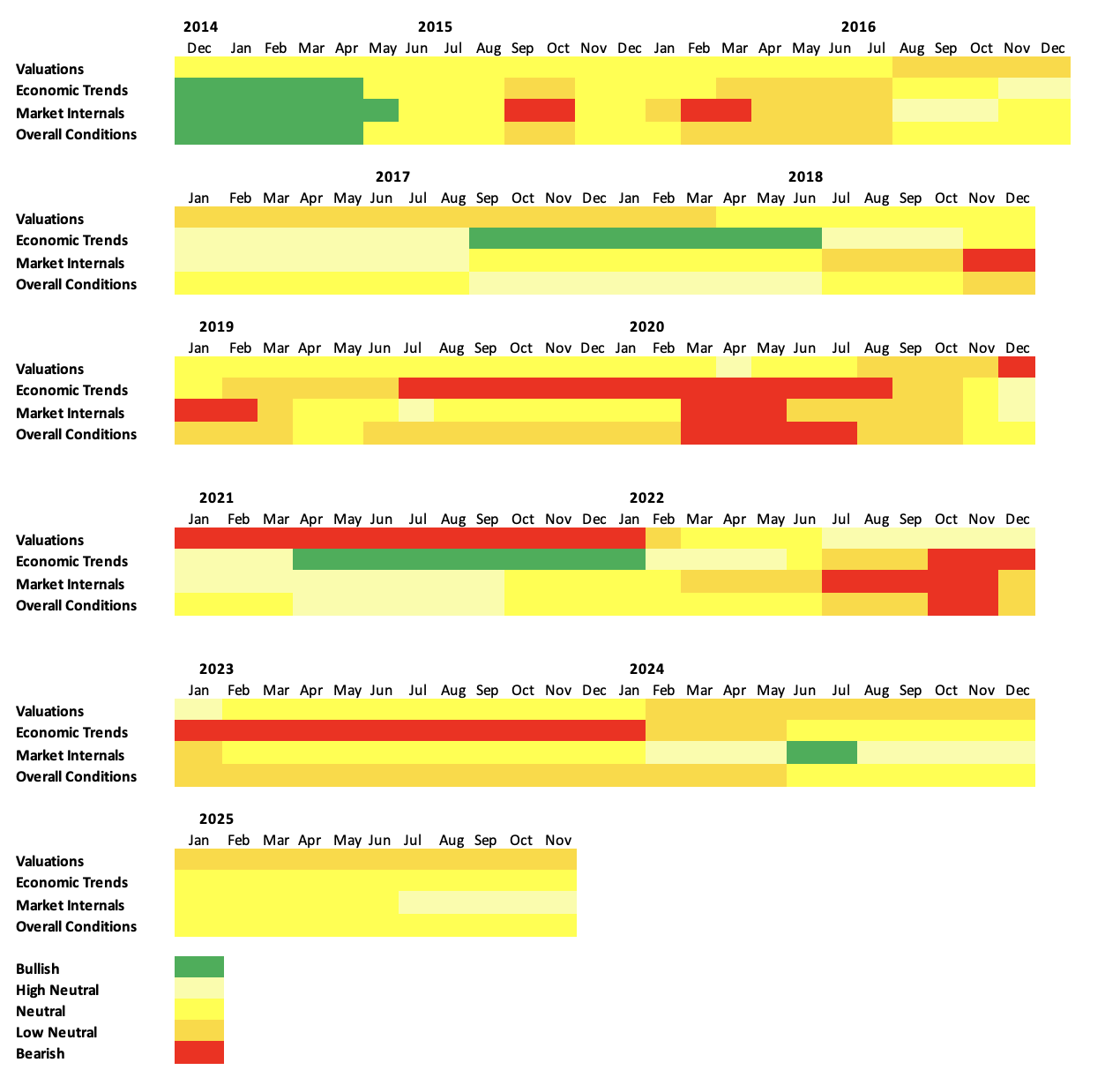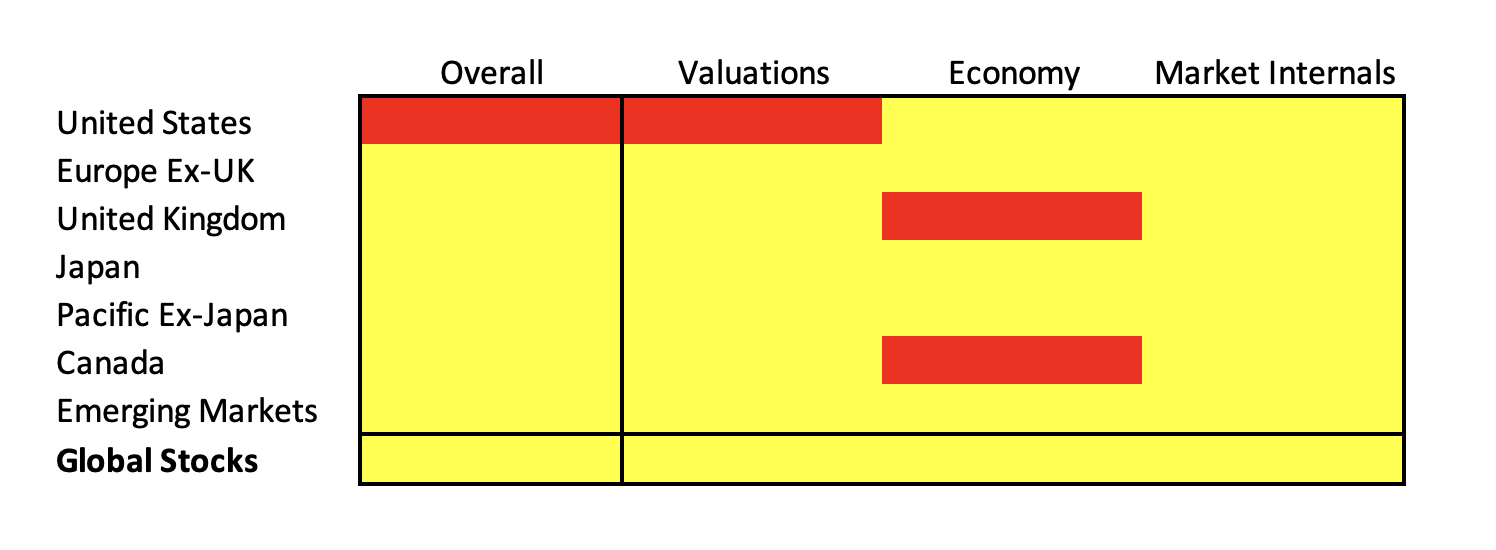This investment strategy report is also available in audio format in the Plus member audio feed.
Become A Member
If you would like to access this investment strategy report, you can do so by becoming a Money For the Rest of Us Plus member.
Learn More About Membership Options »
Investment conditions reports from earlier periods can be found here.
What Happened?
Global stocks, as measured by the MSCI All Country World Index, rose 2.1% in U.S. dollar terms in October, bringing year-to-date returns to 21.1%. Gains this year have been driven by double-digit earnings per share growth in the U.S. and emerging markets, along with increasing valuations.
Non-U.S. stocks, including emerging markets, have outperformed the U.S. by more than 10% year-to-date in U.S. dollar terms, and by over 4% in local currency terms.
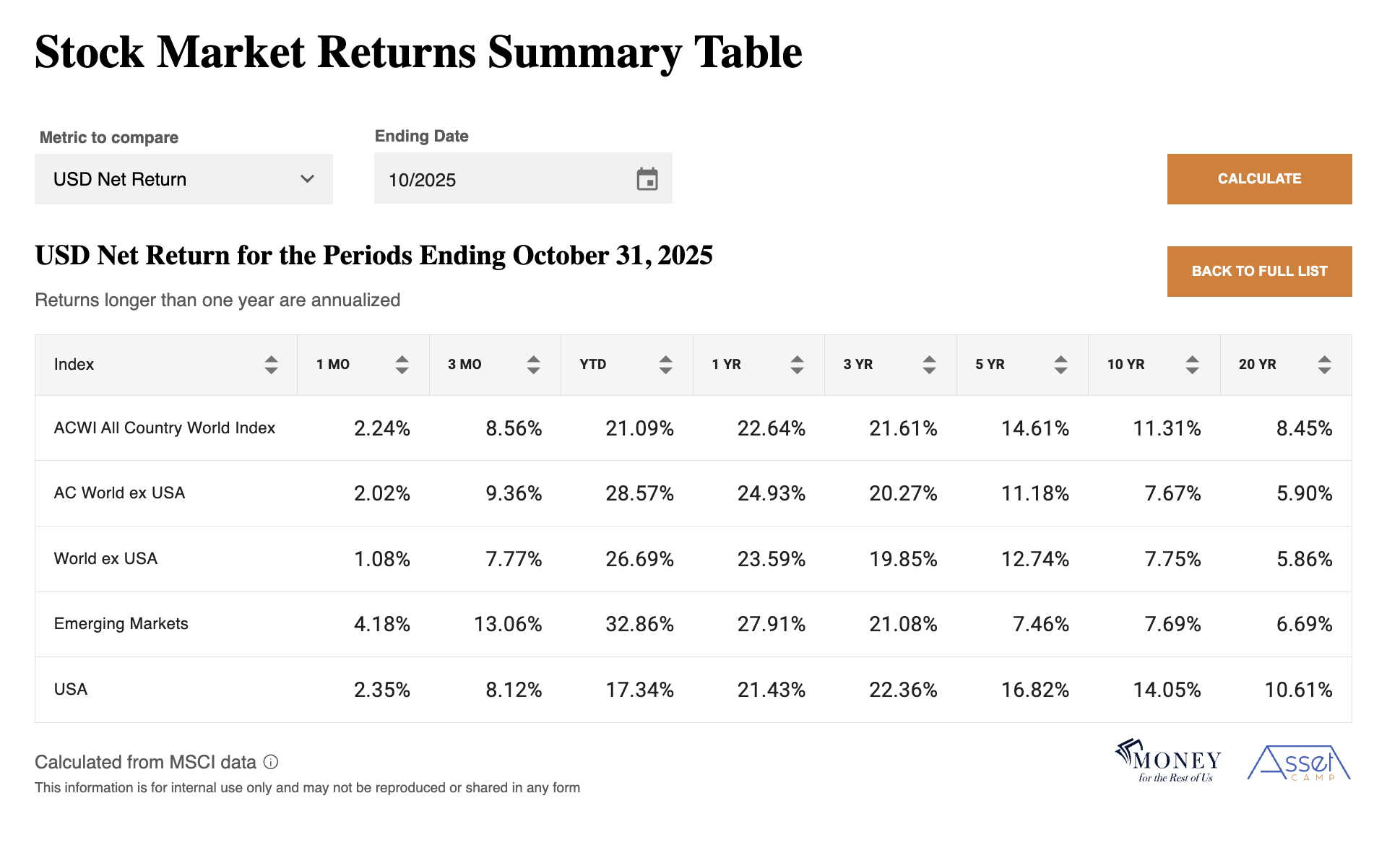
U.S. AI-related companies, along with leading chip manufacturers in Taiwan and Korea, were among the strongest performers in October. Their gains helped propel U.S. Growth and Emerging Markets Growth stocks to roughly a 5% return for the month.

Seven of the eight worst-performing stock indexes year-to-date have been U.S. indexes.
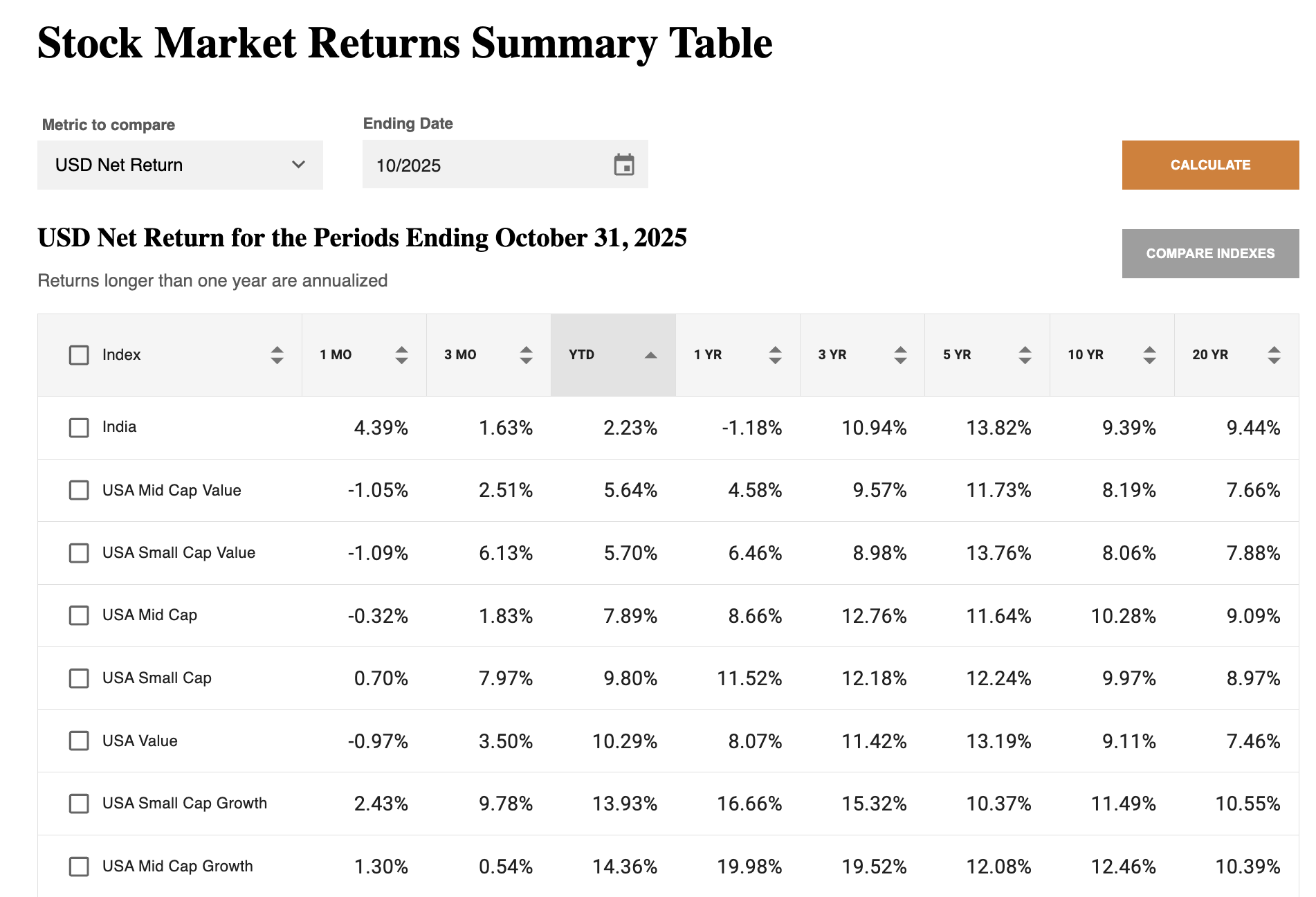
Bond Market Update
Global bond markets were mixed in October. The best performers were UK, Asia Pacific, and Emerging Markets bonds, which saw the largest drop in yields.

The U.S. dollar gained more than 2% in October, leading to a slightly negative return for the U.S. dollar-denominated Global Aggregate Bond Index.
A stronger dollar reduces the returns of overseas bonds when converted to U.S. dollars.
U.S. bonds were modestly positive as Treasury yields declined. Investment-grade corporate bond yields were little changed, while non-investment-grade bond yields rose about 8 basis points during the month but remain 0.7% lower than at the start of the year.
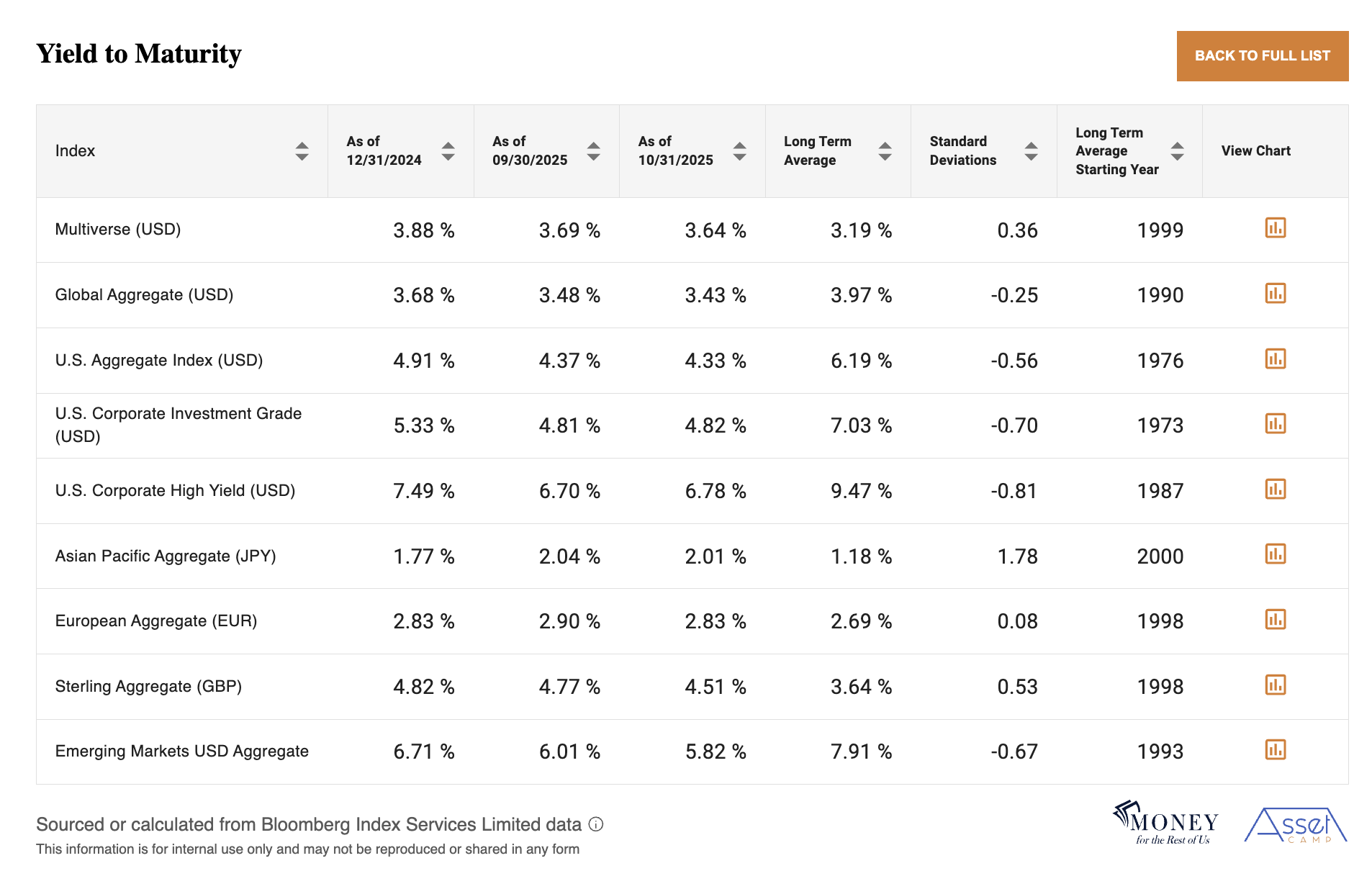
The incremental yield or spread for U.S. non-investment grade relative to U.S. Treasuries increased for the first time since April 2025, but remains near a record low.
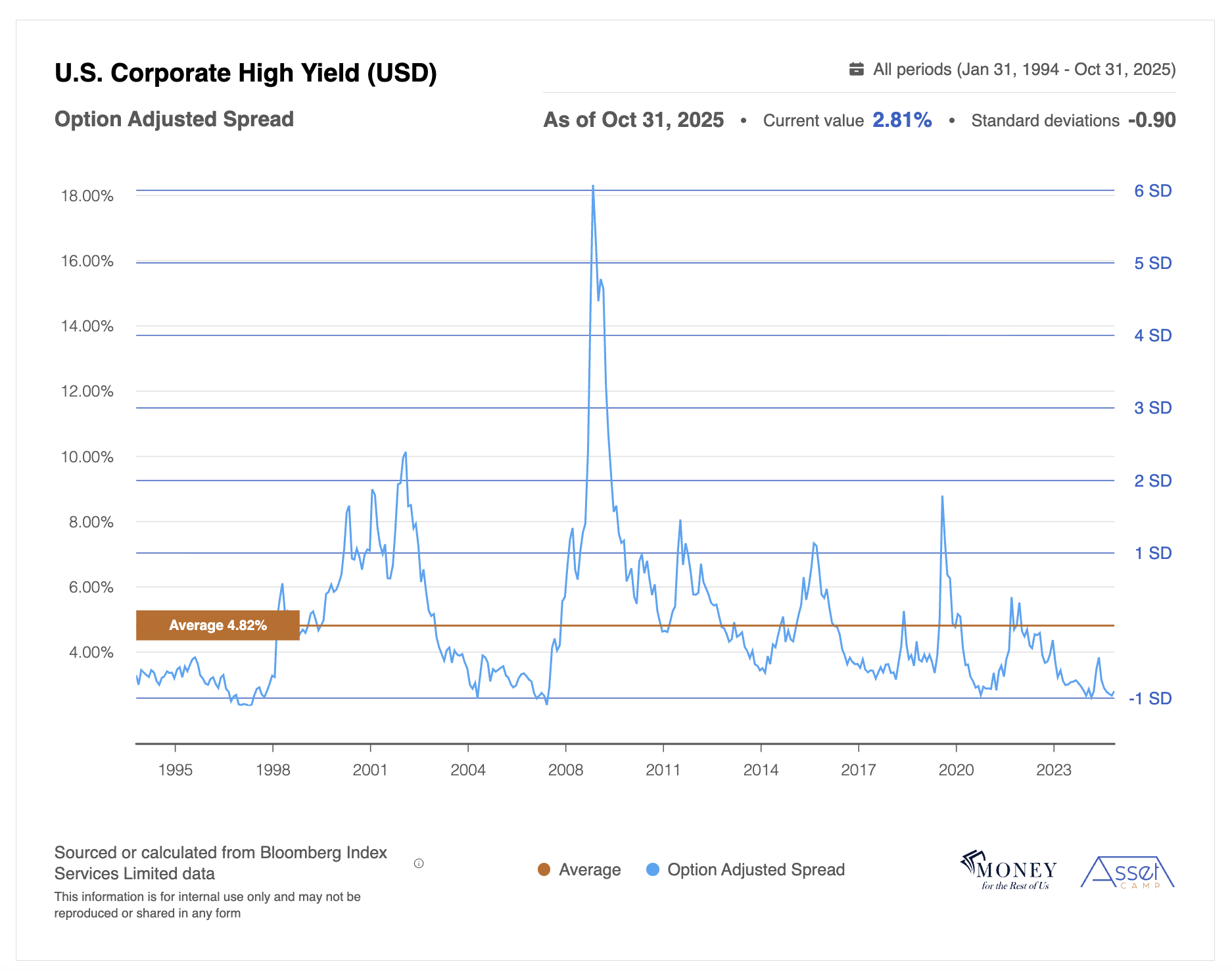
Gold
Gold prices reached a record high in October, rising above $4,300 per ounce and gaining more than 60% year-to-date. Prices have since pulled back to around $4,000 per ounce.
While several central banks continue to steadily accumulate gold reserves, much of the recent price surge has been driven by speculative investor demand.

Where Are We Now
In 2025, financial markets have largely looked past any negative impacts of the U.S. federal government shutdown, higher tariffs, and immigration crackdowns. Investor concerns about these issues have been overshadowed by optimism surrounding the potential productivity revolution driven by artificial intelligence.
The U.S. federal government shutdown continues, as Congress has yet to authorize funding for the new fiscal year. It is now the longest shutdown in history, surpassing the 35-day closure from December 2018 to January 2019. The main sticking point is whether the federal government will continue funding expanded health insurance subsidies for plans purchased under the Affordable Care Act (ACA).
While investors have largely dismissed the shutdown’s political standoff, its real-world effects are mounting. Health-insurance premiums for unsubsidized ACA plans are set to rise 40% or more next year, squeezing household budgets and contributing to higher inflation.
Air travel disruptions may ultimately push lawmakers to reach an agreement to reopen the government. Flight delays have increased as air traffic controllers—working without pay—miss more shifts, with some taking second jobs to cover expenses. The Trump Administration announced it would cut 10% of flights at 40 airports due to the air traffic controller shortage.
The shutdown has also disrupted the release of key economic data, including the monthly jobs report, which hasn’t been published in nearly two months. Federal Reserve Chair Powell likened the lack of data to “driving in fog,” noting that the Federal Open Market Committee will proceed cautiously with further rate cuts until essential data becomes available.
At its most recent meeting, the Federal Reserve reduced its policy rate by another 0.25%, bringing the target range to 3.75%–4.00%. Further reductions are not a given, both because of the data gap and the Fed’s belief that short-term interest rates may already be within the so-called neutral range, the level that supports full employment and stable inflation.
If the new neutral rate is between 3% and 4%, that’s roughly 0.5% to 1.5% higher than pre-pandemic estimates. This range allows savers to earn a positive real return net of inflation, while keeping U.S. 30-year mortgage rates near 6%, almost double the average rate from four years ago.

U.S. Tariffs and Immigration Impact on Federal Reserve Monetary Policy
The sharp rise in the U.S. effective tariff rate to 18%, the highest level since 1934, also complicates the Fed’s policy decisions, due to the tariffs’ inflationary impact.
According to the Federal Reserve Bank of St. Louis, companies have passed through between 20% and 40% of tariff costs as higher prices. The St. Louis Fed estimates that tariffs increased the annual inflation rate by roughly half a percentage point from June through August 2025.
While the inflationary impact of tariffs is unlikely to lead to entrenched inflation, the price increases will be spread out over a year or more as companies gradually pass on higher costs to consumers as firms replenish inventories.
The fate of many of these tariffs will be decided by the courts. The U.S. Supreme Court deliberated in early November on whether the Trump administration’s tariffs exceeded its authority under the International Emergency Economic Powers Act of 1977.
The Federal Reserve is also monitoring the inflationary impact of the crackdown on illegal immigration.
Last month, the U.S. Department of Labor warned that immigration enforcement measures could significantly disrupt the U.S. agricultural labor market. The Department does not expect unemployed or marginally employed U.S. workers to replace the large number of undocumented laborers who are leaving the workforce due to heightened deportation risks. Structural factors, such as the geographic concentration of farms, the seasonal nature of many crops, and the historically low national unemployment rate, limit the domestic labor supply available to fill these roles.
Agricultural work remains among the most physically demanding and least mechanized occupations in the U.S. economy. Fruit, nut, and vegetable production depends heavily on manual labor that cannot be quickly automated.
If immigration enforcement continues to tighten, agricultural employers may face acute labor shortages and higher wage pressures. These dynamics could raise food production costs, contributing to broader inflationary pressures, particularly in fresh produce and specialty crops. While some mechanization and labor substitution may occur over time, short-term adjustments are likely to be limited, suggesting a potential near-term headwind for food supply and prices. Such cost pressures could further complicate the Federal Reserve’s efforts to bring inflation sustainably back to its 2% target.
In short, ongoing uncertainty around inflationary pressures from tariffs, immigration crackdowns, rising health insurance premiums, and other factors gives the Federal Reserve reason to keep its policy rate on hold. That uncertainty is compounded by the lack of timely economic data caused by the U.S. government shutdown.
The AI Buildout
The scale of announced investment in artificial intelligence infrastructure is staggering. Hyperscalers and chip manufacturers are committing hundreds of billions of dollars to expand data-center capacity, construct new power generation, and secure the physical infrastructure required to train and deploy AI systems.
Barclays estimates that announced AI data-center projects now exceed 46 gigawatts of computing capacity, requiring more than 55 gigawatts of electricity if operated at full power, roughly equivalent to the energy needs of tens of millions of homes. The total cost of this buildout could approach $4 trillion by the end of the decade.
About sixty percent of U.S. data-center capital expenditures go toward imported components, particularly semiconductors from Taiwan, South Korea, and Vietnam. That has been a major reason their equity markets have rallied this year.
Still, the line between productive investment and speculative excess is becoming increasingly blurred. A growing share of new capacity appears geared not toward current, verifiable demand as companies integrate AI into workflows, but toward expectations of exponential adoption. Meta CEO Mark Zuckerberg recently stated that the strategy is to “aggressively front-load building capacity” to be prepared for the most optimistic scenarios.
History suggests infrastructure booms rarely end smoothly. The overbuilding of fiber-optic networks in the late 1990s or railroads in the nineteenth century left many investors with losses even as those assets became the foundation for future growth. AI’s physical footprint of data centers, transmission lines, and cooling systems could follow a similar pattern. Some projects will prove uneconomic, but the capacity that remains, along with more advanced AI models, could underpin a new wave of productivity growth. Given the greater interconnectedness of today’s world, advances in AI are likely to spread and be adopted more quickly across the global economy, resulting in a larger boost to productivity.
The challenge for investors is determining whether U.S. stock market valuations already reflect AI’s best-case scenario. JPMorgan estimates that as much as 45 percent of the S&P 500’s market capitalization is now tied to AI-related themes, as a narrow group of technology companies drives index performance. While the AI buildout has supported earnings growth and equity returns this year, it also heightens vulnerability if the expected productivity gains take longer to materialize.
A prudent approach for diversified investors is to maintain exposure to leading AI companies while emphasizing less expensive areas of the market, such as non-U.S. small-cap value stocks, that may also benefit over time from the broader productivity tailwinds of AI adoption.
Economic Trends
The macroeconomic environment has been supportive of this year’s equity market advance, as leading economic indicators remain in expansion territory.
The JP Morgan Global Composite PMI business survey, which encompasses both manufacturing and service businesses, remains in expansion territory. Both manufacturing production and service sector business activity accelerated in October, with new orders reaching a 17-month high.
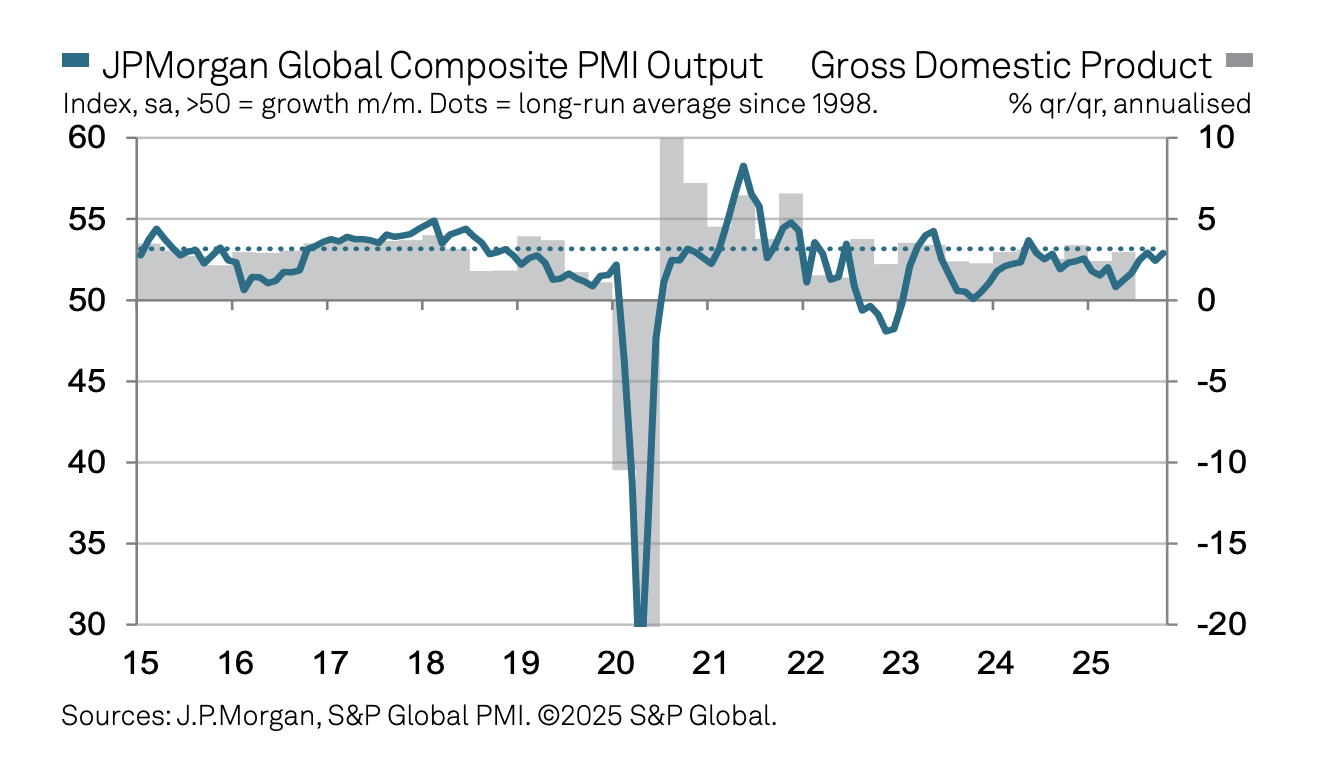

Manufacturing PMIs

Services PMIs
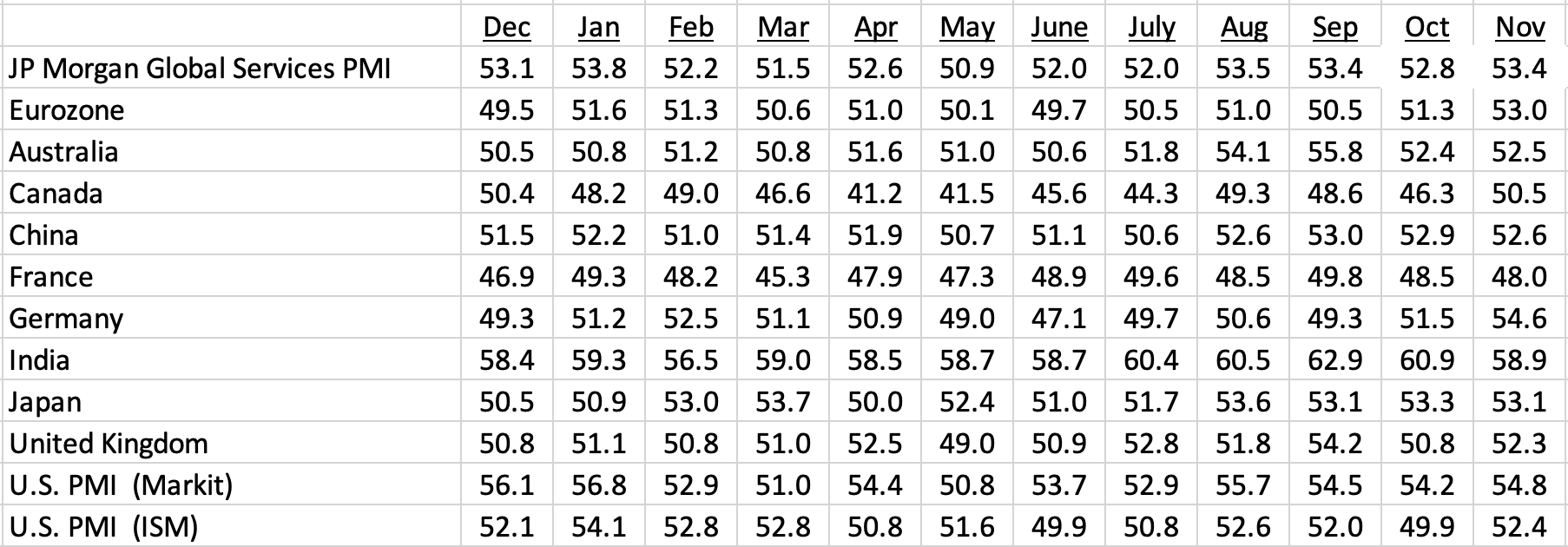
With the U.S. government shut down, investors are dependent on private industry estimates to assess the strength of the U.S. economy.
U.S. government reports on Q3 GDP, employment, personal spending, and savings have all been delayed. Only the monthly Consumer Price Index report is being released by the Federal government because the data is needed to make principal adjustments on U.S. Treasury Inflation-Protected Securities.
Private estimates of the U.S. employment situation is mixed. ADP reported that a meager 42,000 private sector jobs were created in October, the first increase since July.
Conversely, private estimates of new weekly unemployment benefit claims suggest there hasn’t been a big jump in unemployment. Yet, Challenger reported that U.S. employers have announced 1.1 million job cuts in the first ten months of 2025, representing a 65% increase from the same period in 2024. In October 2025, the number of layoff announcements by U.S. companies was the highest in 20 years.
Challenger pointed to AI adoption, softening consumer and corporate spending, and rising costs as the reasons for job reductions.
U.S. PMI business surveys do not indicate an economic slowdown, nor do corporate profit growth expectations. This suggests that, for now, companies have slowed hiring to focus on AI-related efficiency and automation rather than workforce expansion.
Corporate Profits
Global earnings per share growth increased to 10% for the year ended October 2025, driven by the U.S. and emerging markets. Developed market earnings outside of the U.S. grew 4.5% in the past year in U.S. dollar terms, suggesting earnings fell in local currency terms.
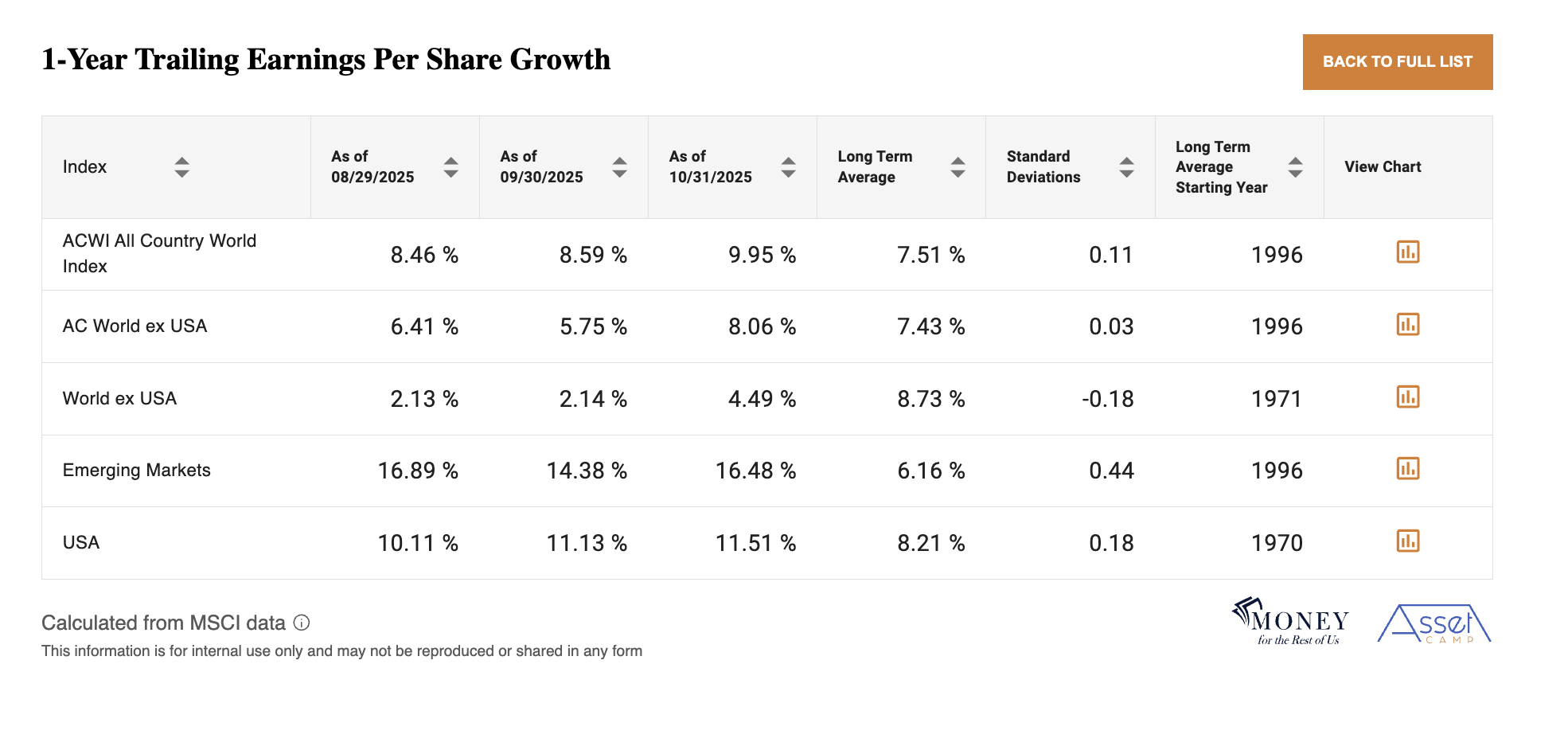
Where Are We Heading
Global earnings expectations have improved. Analysts now see earnings per share rising 12.3% over the next year, up from 10.9% two months ago. The upgrades largely reflect margin expansion as companies tighten their spending and slow hiring, while finding incremental productivity gains, including those from emerging AI applications.
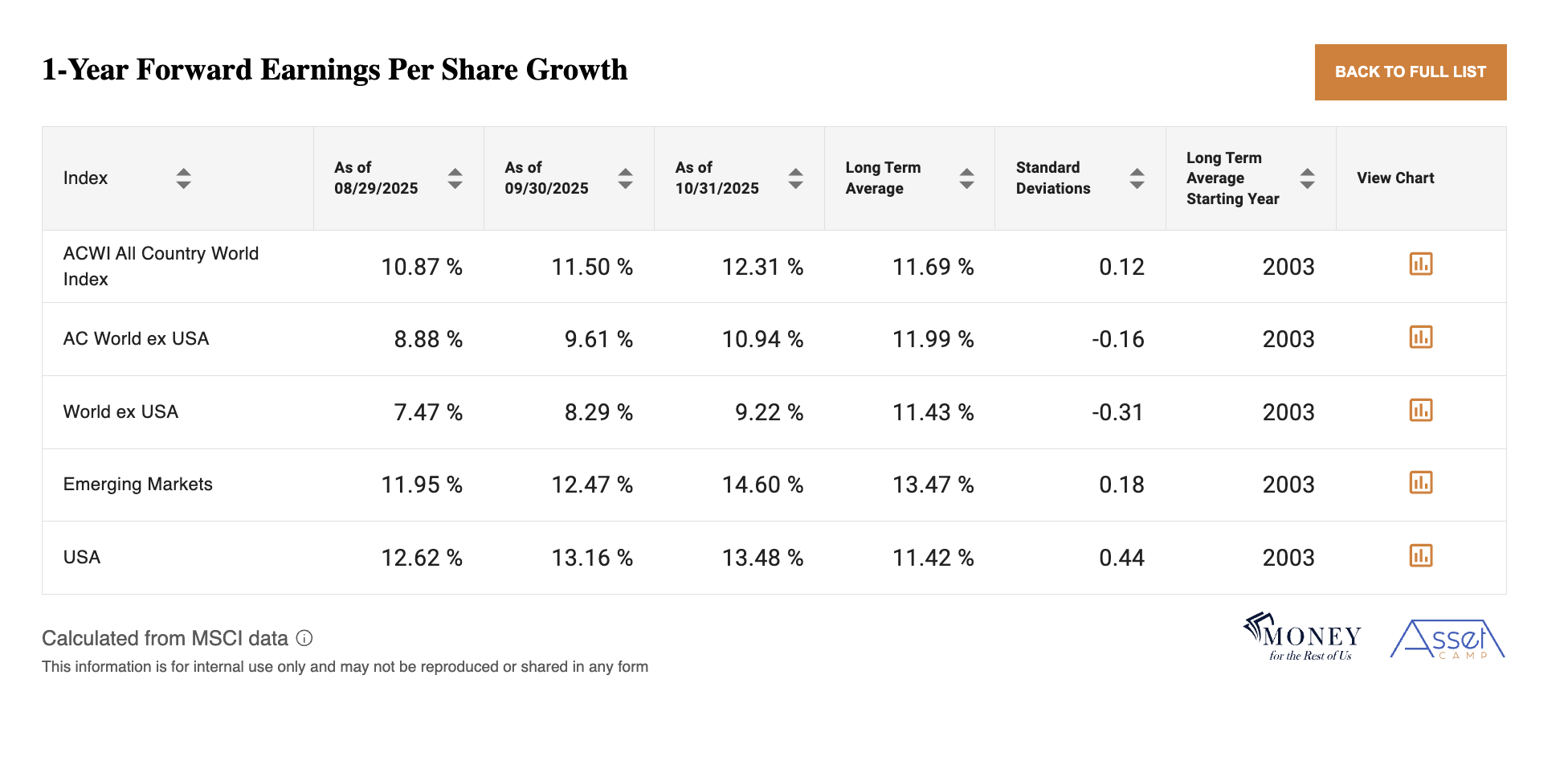
Analysts are even more bullish regarding earnings per share growth over the next three to five years.
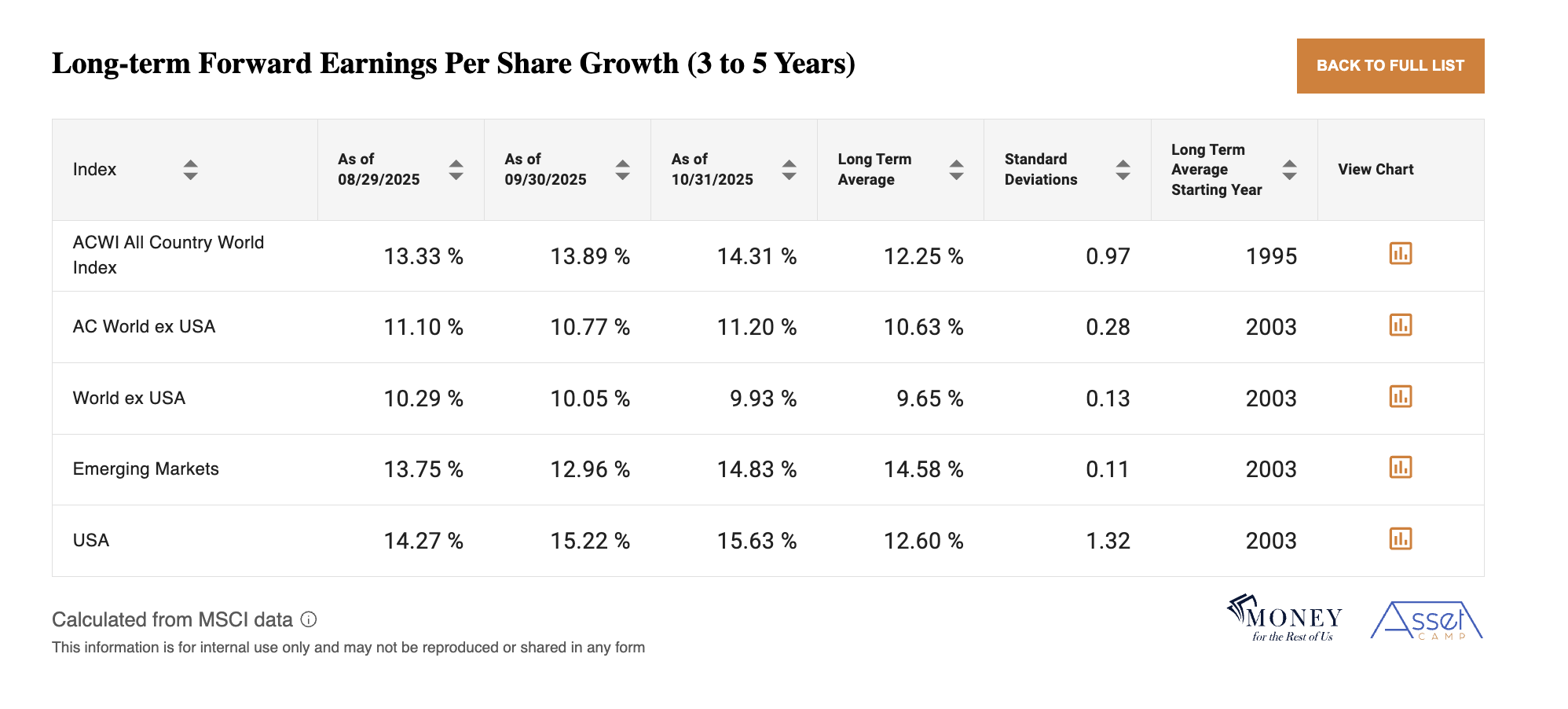
With stock markets appreciating faster than earnings, stocks have gotten more expensive this year. That rally has propelled global stock valuations to their highest level since 2007, based on the cyclically-adjusted P/E ratio, which uses 10-year inflation-adjusted earnings.
Global stocks are priced at 28 times 10-year inflation-adjusted earnings and 20 times expected one-year earnings. Both valuation metrics are two standard deviations above the average. This valuation level implies limited margin for error should earnings growth or productivity gains disappoint.

The U.S. market, which is at the center of the AI boom, is the most expensive stock market in the world.

Valuations for non-U.S. and small-cap equities are more reasonable, although even their valuations are rising.

For example, non-U.S. small-cap value stocks at the beginning of 2025 were selling at 10.4 times expected earnings, 1.2 standard deviations cheaper than average.
Now, after returning 31% year-to-date, the non-U.S. small-cap value forward P/E ratio is 12.5, only one-half standard deviation cheaper than average.
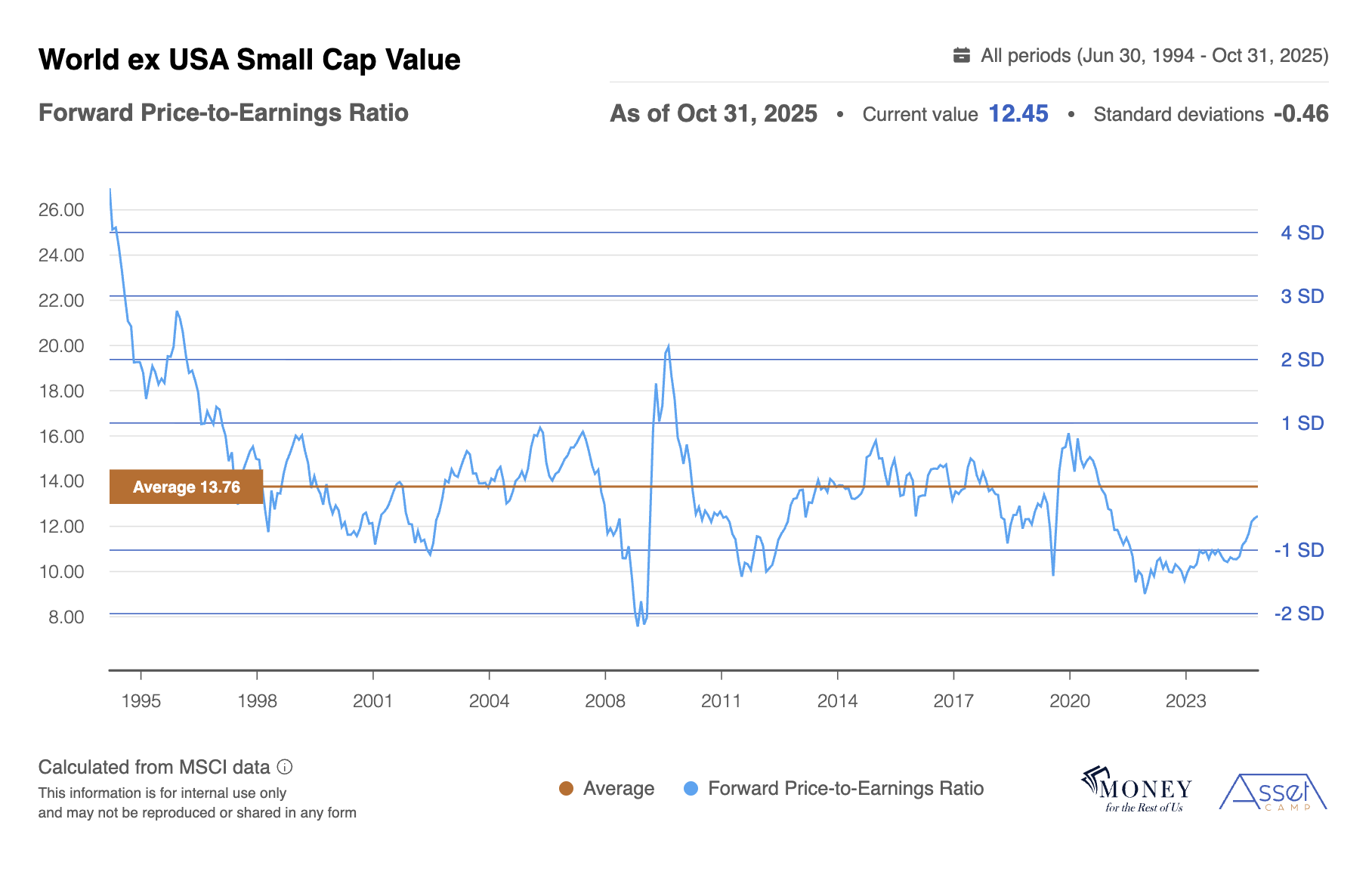
Over the past six months, global stocks have returned 23%, taking the MSCI AC World Index well above its 10-month moving average.
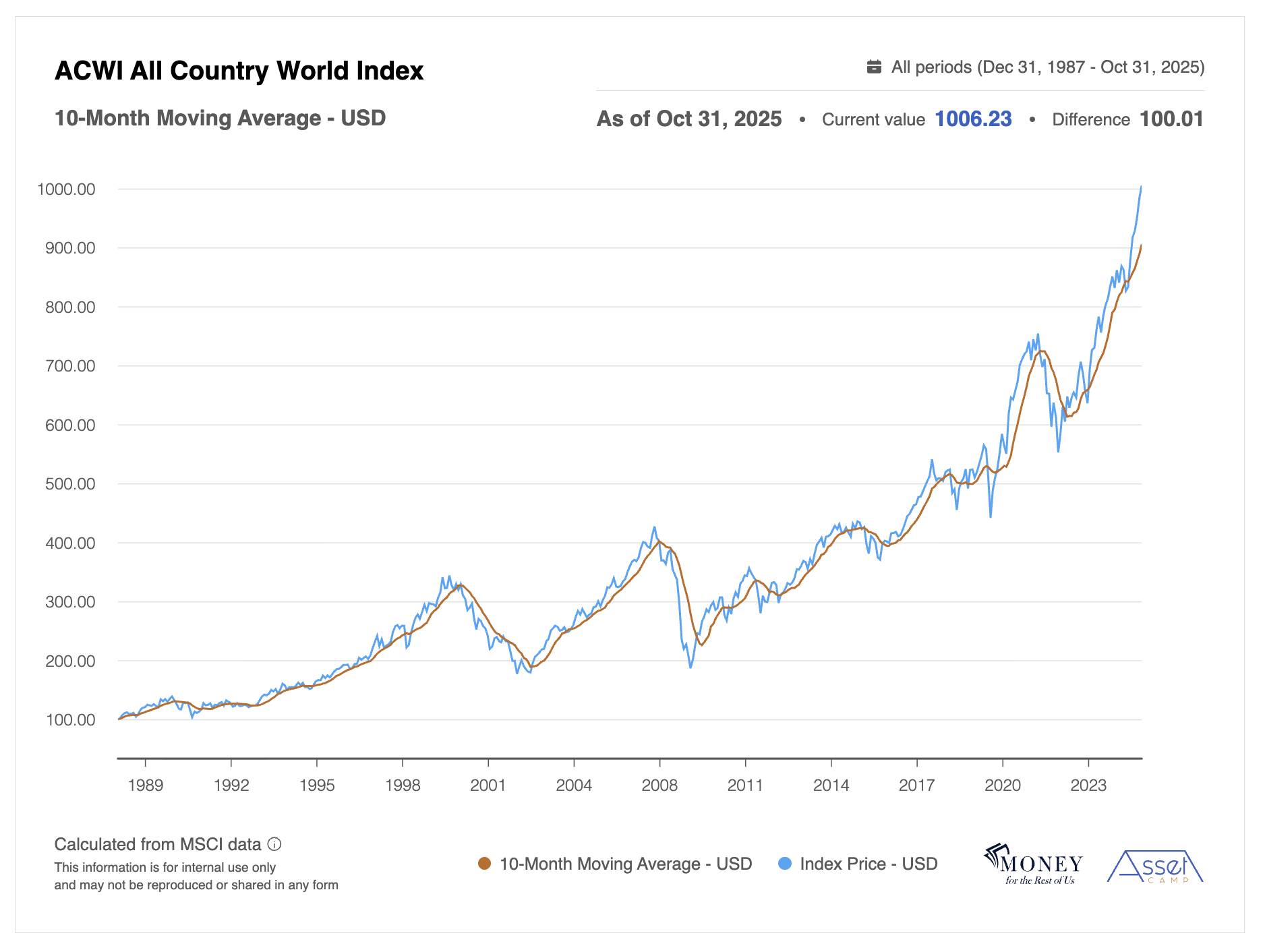
Portfolio Positioning
Investors should maintain strategic exposure to risk assets while remaining mindful of valuation and geopolitical risks.
U.S. large-cap stocks remain expensive relative to history, supporting an underweight stance. Non-U.S. stocks, including small caps, continue to offer more compelling valuations.
Still, with the U.S. comprising 65% of the global stock market, investors should maintain a meaningful allocation to the country’s stock market given the nation’s economic dynamism, especially given its role in the AI buildout.
In fixed income, investors can still earn positive real returns with short-duration instruments, including cash. Bullet ETFs and individual bonds, including Treasury Inflation-Protected Securities, present attractive opportunities to lock in yields and benefit from price appreciation if interest rates fall.
Credit markets offer relatively high nominal yields, but widening spreads and rising default rates could subtract several percentage points from returns if the global economy slows. Higher-rated collateralized loan obligations provide a more resilient way to participate in credit markets.
Long-duration bonds remain vulnerable to interest rate risk, particularly if government fiscal concerns dominate the fixed-income narrative, resulting in higher term premiums.
We will continue to monitor market conditions and political developments to evaluate whether portfolio adjustments are necessary.
For now, the lack of economic data from the world’s largest economy makes it difficult to assess whether an economic shift has occurred. Even when the U.S. government reopens, there will be a delay before accurate data becomes available.
Investment Conditions Summary
